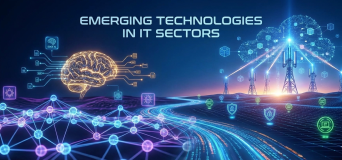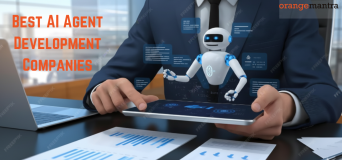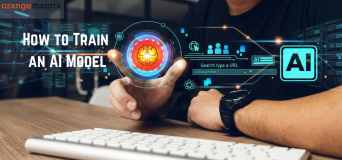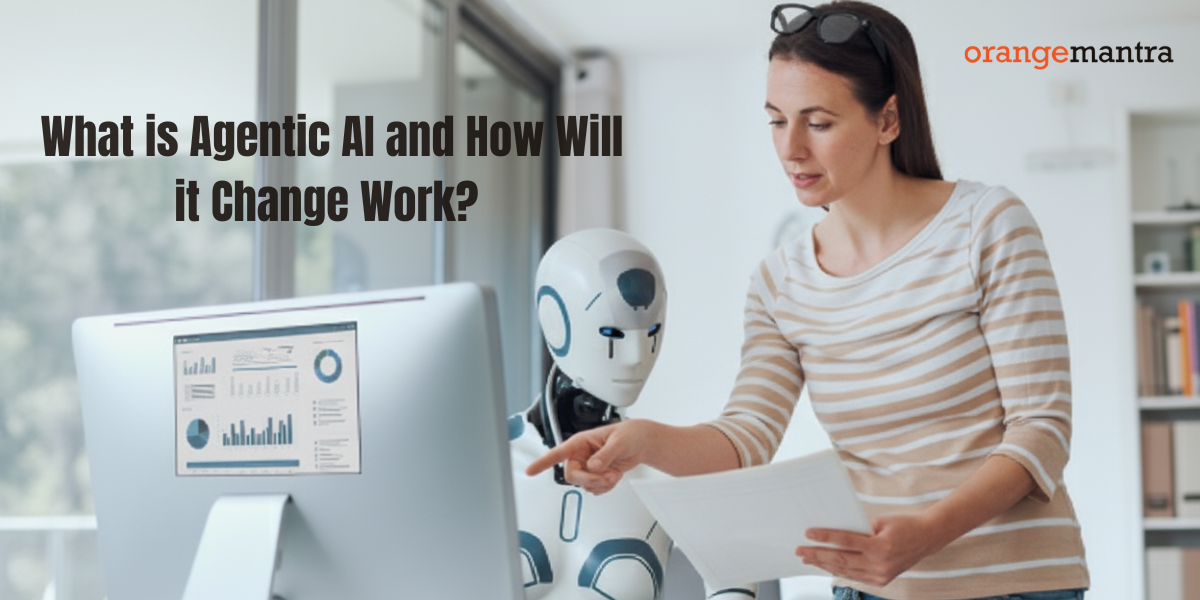
In this blog, you’ll gain a clear understanding of what Agentic AI is, how it differs from traditional AI, and why it’s set to transform the way we work. You’ll explore real-world use cases, design patterns, and practical steps for building AI agents. Plus, we’ll break down how Agentic AI compares with RPA, and what businesses should do today to prepare for a future where AI doesn’t just assist—but takes action.
We humans naturally crave more than advice. We want someone who does things for us, who lightens our load. That’s the difference between a friend who says, “You should work out more,” and a coach who shows up at your door, drags you to the gym, and keeps you going even when you feel like quitting.
That’s exactly the leap Agentic AI represents. Traditional AI has been like the friend who is smart, helpful, but ultimately hands-off. So, what is Agentic AI? Well, it is the coach who doesn’t just tell you what’s possible; it rolls up its sleeves and gets the job done on your behalf.
In this article, I will guide you through a top-to-bottom understanding of the term Agentic AI and related queries that I have encountered on the internet.
Table of Contents
What Industry Leaders Say About Agentic AI?
Here are some latest stats from recent surveys conducted by top agentic AI development companies.
- Deloitte: Over 80% of Indian businesses are exploring Agentic AI.
- Gartner: By 2027, 40% of projects may fail due to cost, unclear ROI, or risks.
- Global AI Survey 2025: 29% use Agentic AI today, 44% plan adoption within a year.
- PwC AI Agent Survey: 88% of executives will increase AI budgets this year.
- Salesforce: Indian HR leaders expect 83% growth by 2027.
What is Agentic AI?
Hundreds of millions of dollars are being invested in a single term, Agentic AI. So, what does it really mean? And how is Agentic AI different from an AI agent?
At its core, Agentic AI is a type of artificial intelligence that does not just think but also acts. Traditional AI mainly analyzes data or generates insights. Take ChatGPT, for example. It follows your prompts and gives you content, but it does not take action on its own.
Agentic AI takes the next step. It makes decisions, executes tasks, and adapts in real time.
A simple way to picture it is as a personal digital travel agent that not only finds the best flights but also books the ticket, arranges your cab, and updates your itinerary if plans change.
The term agentic comes from the idea of an AI agent, a system that operates autonomously, has a clear goal, can reason, and has the freedom to take action. It is not a passive tool; it behaves like a proactive teammate that does not just suggest what to do but gets it done.
How Agentic AI Will Change Work?
Let’s directly see the where and how of agentic AI use case in your business.
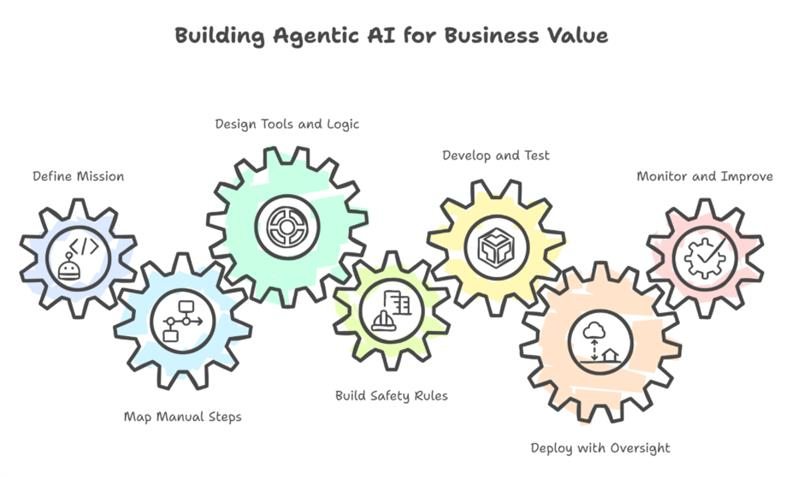
You Become a Manager
Right now, you probably do tasks yourself. You create the report, you send the emails, you enter the data
With Agentic AI, your job changes. You tell the AI what the goal is. Let’s say the goal is to get this new employee everything they need to start. Your agentic AI will go and do all the steps.
Your new job is to check its work, handle tricky problems, and give it new instructions. You move from doing the work to managing the work.
You Talk to the AI
We spend our days switching between different programs: email, Salesforce, your project software. It can be messy.
Agentic AI changes that. You won’t need to open ten different apps. You’ll just tell the Agentic AI what you want in plain English, like “Help me plan the product launch.” The AI will then go into all those different apps itself, find the information, and do the work. You just talk to the AI.
Everything Will Get Much Faster
A lot of work is slow because people are busy, waiting for approval, or it’s after hours. Your agentic AI will be there for you always.
A process that used to take a week, like buying new supplies or getting a client approved, might now take a few hours. This means companies that use agentic AI will be able to move much, much faster than those that don’t.
We Will Need New Rules
Giving an AI the power to do things on its own is a big deal. What if it makes a mistake? How do we keep it safe?
This means companies will need to create new safety rules and jobs focused on watching the AI. We’ll need people to make sure the Agentic AI solutions, or any form of AI is doing the right thing, acting securely, and being fair.
What are Design Patterns in Agentic AI?
In traditional software engineering, design patterns are reusable, proven solutions to common problems. They aren’t finished code, but rather templates that developers use to build reliable, maintainable, and scalable systems.
In Agentic AI, this concept is more important. As we move from building simple, one-off chatbots to complex, autonomous agents, we need a shared language and a set of best practices.
Without them, every agent becomes difficult to build, impossible to scale, and a nightmare to maintain. Design patterns provide the essential blueprint for taming this complexity.
Why Are Design Patterns Important in Agentic AI?
For enterprises, design patterns in agentic AI offer four key advantages:
1. Accelerated Development & Reduced Cost:
Why solve the same problem twice? Patterns provide a proven starting point. Your team doesn’t waste cycles figuring out fundamental agent architecture and can instead focus on customizing the logic for your specific business needs. This drastically shortens time-to-value and lowers development costs.
2. Improved Reliability and Predictability:
Patterns encode best practices for handling challenges like errors, state management, and external API calls.
Using a known pattern like “Human-in-the-Loop” ensures your agent fails gracefully and escalates appropriately, rather than making costly autonomous errors. This builds trust in the system.
3. Enhanced Scalability and Maintainability:
Patterns create a consistent structure across your different agents. When every agent is built using a recognizable pattern, new engineers can understand the codebase faster, and teams can manage, debug, and update dozens of agents without getting lost in a mess of ad-hoc solutions.
4. Clearer Communication and Governance:
Patterns give teams a shared vocabulary. Instead of describing a complex workflow, you can simply say, “We’ll use a Manager-Worker pattern here.” This alignment is crucial for planning, documentation, and establishing governance models across the organization.
Key Agentic AI Design Patterns to Know
While the field is evolving, several core patterns have emerged as essential:
1. The Solo Agent Pattern:
A single AI agent plans and executes a sequence of actions to complete a goal. It’s best for linear, well-defined tasks. Example: An agent that fetches a report, summarizes it, and emails it to a list.
2. The Manager-Worker Pattern:
A “manager” agent breaks a complex goal into sub-tasks and delegates them to specialized “worker” agents. This is crucial for complex, multi-faceted problems.
Example: A “customer research” manager agent delegates tasks to a “web searcher” worker, a “data analyzer” worker, and a “report writer” worker.
3. The Plan-Execute Pattern:
This agent first develops a detailed plan and then executes it step-by-step. Further, it allows validation before any action is taken. This adds a layer of safety and deliberation.
4. The Human-in-the-Loop (HITL) Pattern:
This critical pattern makes sure human oversight directly into the agent’s workflow. The agent must request approval before executing sensitive actions (e.g., spending money, making legal commitments) or when it encounters low-confidence scenarios.
How to Build Agentic AI: Your Step-by-Step Guide
Let’s understand what are the steps to build an Agentic AI that delivers real business value.
Phase 1: Define Your Mission Clearly
Choose one specific process to automate, like IT setup for new engineers. Set clear goals like reducing setup time from days to hours, cut ticket volume, and ensure perfect software access.
Next, map each manual step from receiving the Workday ticket to sending the welcome email so you know exactly what your agent will handle.
Phase 2: Design the Agent’s Tools and Logic
List every API your agent needs: Workday for triggers, Okta for accounts, Microsoft Graph for licenses, and internal tools for hardware orders.
Design a step-by-step workflow where the agent creates accounts, assigns access, and handles provisioning. Most importantly, build in safety rules: require human approval for spending, pause for future start dates, and stop on errors.
Phase 3: Develop and Test Thoroughly
Use a powerful model like GPT-4-Turbo as the agent’s brain. Build and test everything in a sandbox environment. Test perfect scenarios, edge cases, and deliberate attacks to ensure your agent is reliable and secure before it touches real operations.
Phase 4: Deploy with Humans in Control
Now, roll out slowly. Start with one department and expand gradually. Integrate human oversight: send actions to a Slack channel, require approvals for sensitive steps, and alert real people immediately if anything goes wrong. Your team stays in control while automation handles the routine work.
Phase 5: Monitor, Learn, and Improve
Track your KPIs to measure success. Log every action your agent takes. Ask users for feedback, and pay close attention when your team overrides the agent. That’s where you learn. Continuously refine and expand your agent’s skills based on real-world performance.
Is Agentic AI a Futuristic Concept?
This is the most interesting question about agentic AI I have read online. Honestly No. It is not a futuristic concept. The core idea is being actively developed and used right now.
However, a fully autonomous enterprise run by AI without any human oversight is still largely futuristic for most companies. The truth lies somewhere in the middle. Here’s a breakdown to explain why:
What’s Happening Today?
The building blocks of Agentic AI are real and in use. We have the technology for that. This includes AI models like GPT-4, Claude, Llama that can reason and plan. Plus, platforms to build an agentic AI development company like LangChain, CrewAI are available.
Companies are already deploying successful, single-purpose agents. These are agents with a very clear, narrow job and strong guardrails. Examples of this include AI agents in customer service, IT agents, and data analysis agents.
These are not science fiction. They are in production today, delivering real value.
What’s Still Futuristic?
The futuristic part is the scale and level of autonomy we see in movies. Let’s say a fully autonomous “Chief AI Officer”. The idea of an AI that runs entire company divisions, sets its own strategic goals, and negotiates with other AIs is not a reality for businesses today.
The risks are too high.
The fear of “bots taking all the jobs” and humans being completely removed from the loop is exaggerated. The current and foreseeable model is Human-in-the-Loop, where AI handles the routine work and humans provide oversight, handle exceptions, and make the big decisions.
We are far from a point where we can fully trust an AI agent development service to work perfectly 100% of the time on critical tasks without any human supervision. Mistakes happen, edge cases occur, and human judgment is still crucial.
So, my honest take is that agentic AI is like the internet in the early 2000s. The technology was real and businesses were using it, but no one could have fully predicted how it would transform everything decades later.
So, is it a futuristic concept? The answer is both yes and no. The foundational technology is here and working now, but its most advanced and transformative applications are still unfolding.
But another reality is also to start adopting agentic AI today and then scale its use in your business with more advancement.
Agentic AI vs RPA: What’s the Difference and When to Use Which?
Many leaders confuse Agentic AI and RPA which leads to failed pilots and missed opportunities. Use this table to quickly identify which technology aligns with your specific business challenge.
| Aspect | Robotic Process Automation (RPA) | Agentic AI |
|---|---|---|
| Core Function | Task Execution: Automates repetitive, rule-based tasks. | Goal Achievement: Autonomously reasons and completes multi-step goals. |
| How It Works | Mimics human UI interactions (clicks, typing). Follows a strict “if X, then Y” script. | Uses AI to understand context, make decisions, and execute actions via APIs. |
| Flexibility | Breaks if the process, UI, or an unexpected event changes. | Handles variations, exceptions, and learns from outcomes. |
| Data Handling | Works primarily with structured data in predefined fields. | Processes both structured and unstructured data (emails, documents). |
| Best For | Stable, repetitive tasks with clear, unchanging rules. Legacy systems with no API. Use Case: Data entry from invoices into an ERP. |
Complex processes require reasoning and decision-making. Systems with modern APIs. Use Case: End-to-end employee onboarding across multiple platforms. |
| Key Question | “Can we automate this specific, repetitive task?” | “Can we automate the entire decision-based process to achieve this outcome?” |
Conclusion
The window for viewing Agentic AI as a speculative technology has closed. It is now a core competency for engineering and operations leaders who care about resilience, scalability, and capital allocation.
The question is no longer if you will deploy agents, but how competently you will do so.
Remember, the goal is not full autonomy. That is a fantasy that ignores liability, ethics, and simple reality. The goal is supervised agency, creating systems that operate with delegated authority under strict human governance.
Your architecture must be built with this principle at its core; otherwise, you are building a risk and not an asset.
This is ultimately about a change in operating philosophy. The companies that will win are not those with the largest AI research labs, but those that best integrate these systems into their human workflows, measure their impact with brutal honesty, and iterate relentlessly.
Your next step is straightforward: Identify the single most expensive, manual, and error-prone operational process in your business. That is your candidate. Don’t overthink it. Build, measure, and learn. Everything else is just talk.


